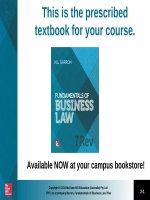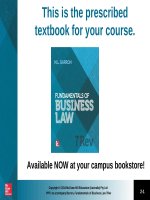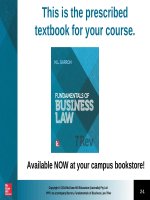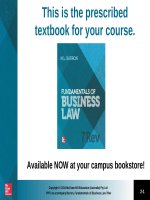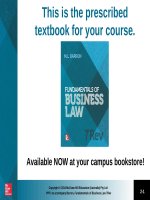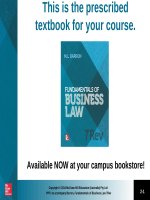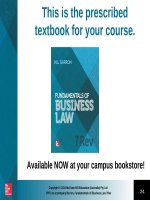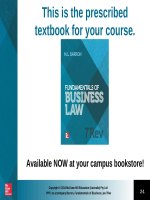- Trang chủ >>
- Thạc sĩ - Cao học >>
- Luật
Lecture Fundamentals of business law (7/e): Chapter 20 - M.L Barron
Bạn đang xem bản rút gọn của tài liệu. Xem và tải ngay bản đầy đủ của tài liệu tại đây (529.42 KB, 36 trang )
This is the prescribed
textbook for your course.
Available NOW at your campus bookstore!
Copyright © 2014 McGraw-Hill Education (Australia) Pty Ltd
PPTs to accompany Barron, Fundamentals of Business Law 7Rev
•2-1
Bankruptcy law
Chapter 20
Copyright © 2014 McGraw-Hill Education (Australia) Pty Ltd
PPTs to accompany Barron, Fundamentals of Business Law 7Rev
•2-2
Learning objectives
At the end of this chapter you should
understand:
• the objectives of bankruptcy law
• the advantages and disadvantages of bankruptcy from
the perspective of the creditor and the debtor
• how the Bankruptcy Act 1966 (Cwlth) is administered
• the difference between a debtor’s petition and a
creditor’s petition
• the term ‘acts of bankruptcy’ and give examples
• the steps involved in obtaining a sequestration order
• the property of a bankrupt that is available for distribution
to creditors
Copyright © 2014 McGraw-Hill Education (Australia) Pty Ltd
PPTs to accompany Barron, Fundamentals of Business Law 7Rev
•2-3
Learning objectives (cont.)
• the order in which creditors’ debts are paid
• the powers of the trustee, including the power to
avoid antecedent transactions
• the procedure for discharge from bankruptcy
• the contrast between the bankruptcy of a debtor with
alternative procedures under Parts IX and X of the
Bankruptcy Act.
Copyright © 2014 McGraw-Hill Education (Australia) Pty Ltd
PPTs to accompany Barron, Fundamentals of Business Law 7Rev
•2-4
Introduction
Bankruptcy
• Where legal possession of a debtor’s
possessions is taken for the benefit of
that person’s creditors.
• Debtor’s property is sold and
distributed fairly amongst creditors,
following which the bankrupt is given a
discharge of their debts.
• May be sought by debtor or creditor
• Regulated by the Bankruptcy Act 1966
(Cwlth)
Copyright © 2014 McGraw-Hill Education (Australia) Pty Ltd
PPTs to accompany Barron, Fundamentals of Business Law 7Rev
•2-5
Objectives of bankruptcy Law
• To assist the debtor
– Will be entitled, once discharged, to make
a fresh start free from the demands of
creditors
• To protect creditors:
– by preventing debtors from disposing of
property when bankruptcy is inevitable
– by distributing the debtor’s assets among
creditors in the swiftest and most
economical manner.
Copyright © 2014 McGraw-Hill Education (Australia) Pty Ltd
PPTs to accompany Barron, Fundamentals of Business Law 7Rev
•2-6
Objectives of bankruptcy law
(cont.)
• To benefit the community:
– by giving a debtor who is hopelessly in debt an
opportunity to make a new start, rather than
remain a burden on the community.
– by imposing limits on the capacity of a person
who is an undischarged bankrupt to enter new
contracts.
Copyright © 2014 McGraw-Hill Education (Australia) Pty Ltd
PPTs to accompany Barron, Fundamentals of Business Law 7Rev
•2-7
Advantages for creditors
• Equitable and proportionate distribution
of debtor’s assets
• Recovery of property that was
distributed prior to bankruptcy
• Possibly uncover more property
available for distribution to creditors by
public examination
Copyright © 2014 McGraw-Hill Education (Australia) Pty Ltd
PPTs to accompany Barron, Fundamentals of Business Law 7Rev
•2-8
Disadvantages for creditors
• Significant fees for administering the
estate, and court costs associated with
the recovery of costs, are paid before
creditors.
• Delays and complications
• Bankrupt must stop trading
Copyright © 2014 McGraw-Hill Education (Australia) Pty Ltd
PPTs to accompany Barron, Fundamentals of Business Law 7Rev
•2-9
Advantages for debtors
• Enables bankrupt to avoid being
sued by creditors for debts
incurred prior to the bankruptcy.
• New start in three years, with
cooperation.
• Bankrupt maintains ‘necessary
property’.
Copyright © 2014 McGraw-Hill Education (Australia) Pty Ltd
PPTs to accompany Barron, Fundamentals of Business Law 7Rev
•2-10
Disadvantages for debtors
•
•
•
•
•
•
•
•
•
Debtor’s property available for settlement of debts
Earnings may be used as contribution towards debts
Stigma attached to bankruptcy
Restrictions in obtaining credit without notifying credit
provider of bankruptcy
Bankrupt’s passport to be surrendered
Cannot be director of company without permission of
Supreme Court
Cannot conduct a business without disclosure of
bankruptcy
Details of bankruptcy published in National Personal
Insolvency Index
Must comply with Bankruptcy Act
Copyright © 2014 McGraw-Hill Education (Australia) Pty Ltd
PPTs to accompany Barron, Fundamentals of Business Law 7Rev
•2-11
Distinction between
bankruptcy and insolvency
• Insolvency
– The person is unable to pay all of his or
her debts as and when they become due
and payable.
• Bankruptcy
– The person is required to provide a
trustee with specified property, to be
distributed among creditors.
Copyright © 2014 McGraw-Hill Education (Australia) Pty Ltd
PPTs to accompany Barron, Fundamentals of Business Law 7Rev
•2-12
Insolvency and Trustee Service
• Bankruptcy matters are administered under
the umbrella of the Insolvency and Trustee
Service Australia or ITSA.
• ITSA provides bankruptcy, trustee and
related services including advice and
regulation in one location.
• Important role in countering illegal activities
and protecting Australian community from
impact of financial failure
Copyright © 2014 McGraw-Hill Education (Australia) Pty Ltd
PPTs to accompany Barron, Fundamentals of Business Law 7Rev
•2-13
Bankruptcy Act 1966—
administration
Inspector-General in bankruptcy
(appointed by Attorney-General’s Department)
Overseas general administration of Bankruptcy Act
State Official Receiver
OR
(appointed by Governor-General)
Registered trustee
(appointed by Federal Court)
Administration and distribution of bankrupt’s estate:
Gathering bankrupt’s estate
Realising non-monetary assets
Distributing dividend to creditors
Copyright © 2014 McGraw-Hill Education (Australia) Pty Ltd
PPTs to accompany Barron, Fundamentals of Business Law 7Rev
•2-14
Official trustee in bankruptcy
A body corporate that holds and
invests property on behalf of the
creditors prior to sale and distribution.
Copyright © 2014 McGraw-Hill Education (Australia) Pty Ltd
PPTs to accompany Barron, Fundamentals of Business Law 7Rev
•2-15
How a person can be made
bankrupt
• Debtor ‘volunteers’ for bankruptcy
– by debtor’s petition
• Debtor is ‘forced’ into bankruptcy
– by creditor’s petition
Copyright © 2014 McGraw-Hill Education (Australia) Pty Ltd
PPTs to accompany Barron, Fundamentals of Business Law 7Rev
•2-16
Bankruptcy by debtor’s petition
(voluntary bankruptcy)
Insolvent
• Declaration of intention s. 54A
(provides stay period)
• Debtor's petition s55
• Statement of affairs
• Acceptance by official receiver
• Sequestration order
• Property of bankrupt vested
in official receiver
Copyright © 2014 McGraw-Hill Education (Australia) Pty Ltd
PPTs to accompany Barron, Fundamentals of Business Law 7Rev
•2-17
Bankruptcy by creditor’s petition
• Initiated by one or more creditors and
presented to the Federal Court.
• If satisfied, court issues a sequestration
order which results in the debtors estate
being vested in the Official Trustee or a
registered trustee for distribution to creditors.
• Process may be expensive and drawn out so
it’s important to consider commercial
realities.
• Usually used when there is a large sum of
money or the debtor has acted fraudulently.
Copyright © 2014 McGraw-Hill Education (Australia) Pty Ltd
PPTs to accompany Barron, Fundamentals of Business Law 7Rev
•2-18
Conditions before creditors’
petition will issue
• Debt owed to creditor/s must be at least
$5000 and be capable of being quantified.
• Debtor must have committed an act of
bankruptcy within a period of six months
before the presentation of the petition.
• Generally the debtor must be resident or
have a residential or business address in
Australia at the time the act of bankruptcy
was committed.
Copyright © 2014 McGraw-Hill Education (Australia) Pty Ltd
PPTs to accompany Barron, Fundamentals of Business Law 7Rev
•2-19
Acts of bankruptcy
• Listed in Part IV, Division I, s. 40 of the
Bankruptcy Act 1966 (Cwlth)
• One of the most common acts of
bankruptcy is a failure to comply with a
bankruptcy notice.
• The Official Receiver may issue the notice
on application of creditor/s who have
obtained a final judgement or order for an
amount of at least $5000.
• The notice requires the debtor to pay within
a prescribed time.
Copyright © 2014 McGraw-Hill Education (Australia) Pty Ltd
PPTs to accompany Barron, Fundamentals of Business Law 7Rev
•2-20
Failure to comply with bankruptcy
notice
Final judgment made
(creditor has right against debtor decided)
Bankruptcy notice served
(based on final judgment order)
– sum due
– deadline to be paid
Debtor complies
Debtor doesn't comply
no act of bankruptcy
commits act of bankruptcy
Prove debt not owed
Pay debt
– counterclaim
– set-off
– cross demand
Creditor presents petition
for bankruptcy (> $5000 owed)
Served on debtor
Court makes
sequestration order
Debtor automatically bankrupt
Copyright © 2014 McGraw-Hill Education (Australia) Pty Ltd
PPTs to accompany Barron, Fundamentals of Business Law 7Rev
•2-21
Court proceedings for sequestration
order
Bankruptcy notice
Act of bankruptcy
(failure to comply with bankruptcy notice)
Creditor’s petition
(presented by creditors with >$5000 owed S44)
Served on debtor
Debtor attends bankruptcy court
hearing of the creditor’s petition
Prove:
creditor’s
debt exists
debtor committed one or more acts of
bankruptcy within six months before
petition presented
service of petition of debtor
Court makes sequestration order
Copyright © 2014 McGraw-Hill Education (Australia) Pty Ltd
PPTs to accompany Barron, Fundamentals of Business Law 7Rev
•2-22
Sequestration order
(on creditor’s/debtor’s petition)
• Administration of the estate:
– Debtor files statement of affairs (assets/liabilities)
within 14 days
– Trustee calls creditors to meeting within 28 days
– Public examination of debtor
– Creditors prove debt exists
– Trustee realises assets
– Trustee pays dividends to proven creditors
– Debtor freed from all provable debts
Copyright © 2014 McGraw-Hill Education (Australia) Pty Ltd
PPTs to accompany Barron, Fundamentals of Business Law 7Rev
•2-23
Proof of debt
Secured
Rely on
security
Estimate
security
Unsecured
Realise/surrender
security
Shortfall
Proof of debt
Amount
How incurred
Substantiation
Copyright © 2014 McGraw-Hill Education (Australia) Pty Ltd
PPTs to accompany Barron, Fundamentals of Business Law 7Rev
•2-24
Assets available to the trustee
• Assets of bankrupt owned on day of
bankruptcy, i.e. earliest act of
bankruptcy that can be counted, within
last six months
• Assets bankrupt acquires while
bankrupt
• Income above threshold amount
(includes the value of fringe benefits
and money paid to associated entities)
Copyright © 2014 McGraw-Hill Education (Australia) Pty Ltd
PPTs to accompany Barron, Fundamentals of Business Law 7Rev
•2-25
